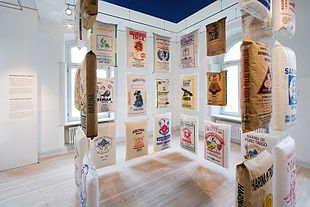MehlWelten Museum
The MehlWelten Museum on the Amtsberg in Wittenburg ( Mecklenburg-Western Pomerania ) is a cultural-historical collection of sacks of flour . With around 3,100 exhibits from 130 countries, it is considered to be the most extensive of its kind. The permanent exhibition was designed by the cultural scientist and curator of the museum, Angela Jannelli, as a world of experience on the subject of flour , and exhibits are recorded and interpreted according to their symbolism . In 2010 the Flour art award 2010 competition was announced to honor the sender of the 2010th flour sack.
History and future
The collection owes its origin to a chance find. In 1998 Volkmar Wywiol discovered a sack of flour from an Arab milling company on the beach in Dubai . The Hamburg artist Armin Sandig turned this sack into a work of art that is shown in the foyer of the “MehlWelten Museum”. Little by little, this beginning became the largest collection of flour sacks in the world. Numerous mills support the flour sack project with new exhibits. The museum was handed over in June 2008 by the Prime Minister of Mecklenburg-Western Pomerania, Harald Ringstorff . The owner is Mühlenchemie, a company of the Stern-Wywiol Gruppe .
It is planned to add the history of flour to the presentation of the flour sacks and their iconography . A panorama of the cultural and technological history of grain-based food is to be spread out in six rooms using film. The main topics will be: the development of cultural grains since the Neolithic Revolution 10,000 years ago, grain nutrition as a factor in world history, grain as reflected in the religions, the evolution of milling technology, an overview of grain products all over the world and an outlook on the future of flour.
exhibition
At the entrance there is the " Schöne Müllerin ", a flour sack installation that welcomes visitors in several languages when pressed by hand.
The world space is based on the motto “Share your bread and it tastes better. Share your happiness and it will get bigger ”. Sacks of flour from different cultures are supposed to give an impression of the great importance of flour for feeding the world population.
In the myths room , myths from different epochs and societies are presented, which entwine themselves with grain, bread and mills, including a replica of a maid grinding grain from Pharaonic Egypt, a Greek coin with the head of Persephone and an ear of wheat from 350 BC on the reverse. As well as a paper theater of the Black Forest " Altweibermühle " from the 19th century.
The symbol room deals with the symbolism depicted on flour sacks. The sun is a symbol of life and a symbol of rulership, there are also symbols of power and strength that indicate the energy stored in the grain, as well as the symbolism of tradition and craft.
The white room is supposed to give the visitor an impression of the purity of the ground grain with spherical sounds.
The heart of the museum is the bag library . The exhibits are stored here, sorted by country.
In this room there is also a mystical thread picture by the Berlin artist Kathinka Willinek. It shows a representation of the grain and fertility goddess Demeter , who according to Greek mythology gave the people the grain.
In 2017 the museum was expanded to include new themed rooms that deal with the prehistory of wheat cultivation. On permanent loan and in close cooperation with the South Tyrol Museum of Archeology in Bolzano , a replica of the prehistoric find Ötzi is on display.
In the exit area there is a replica of a bran puke that originally "spat out" the bran that was produced when sieving out the flour. This object is a replica of the bran puke from the Lindigtmühle in Kohren-Sahlis, Saxony .
Museum building
The neoclassical building was erected in 1848 on the Amtsberg, the original location of a medieval castle and palace complex, and was initially used as a district court, later as a Soviet headquarters, and until 2007 as a school. Under the direction of the architect Carsten Falkenberg and the curator Angela Jannelli, the interior was restored from 2005 to 2008.
See also
- Sack Museum in Nieheim , North Rhine-Westphalia
literature
- art and flour - A global gallery of flour sacks . Robert Wenzel Verlag, Hamburg, ISBN 978-3-00-021538-4
- flour art museum - exhibition companion . June 2008
Web links
Individual evidence
- ↑ a b Preußische Allgemeine Zeitung, 34/2010, August 28, 2010
- ↑ News from June 22, 2017 on presseportal.de, accessed on March 22, 2018
Coordinates: 53 ° 30 ′ 51.8 " N , 11 ° 4 ′ 20.4" E



